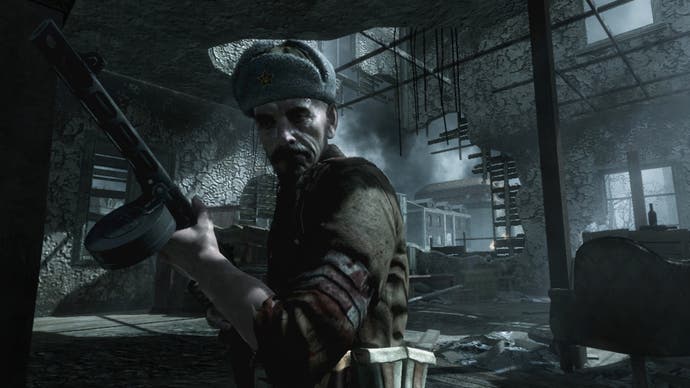Call of Duty: World at War
Still soldiering on.
In fact, the AI in general is spotty. When you're doing what the game wants - carefully dashing from cover to cover and playing whack-a-mole as the enemies pop up from the same places - the computer controlled troops move and fight convincingly. Break from the routine, advance faster than you're expected to, and you'll start to see enemies standing blindly by as you stand next to them, sniping their comrades, or friendly soldiers angrily shooting walls and rocks.
Despite these hiccups, it generally looks phenomenal, providing you're looking in the right places. This isn't a game where physics plays much of a part and it instead uses similar tricks to Burnout - depth of field, peripheral blurring - to make sure you get the most satisfying view of the action as you barrel onwards. There's now a flamethrower weapon, which apparently provides realistic propagating fire. It rarely works out that way though. Flames flicker on items after the gushing inferno has died away, but they soon sputter out like the automated textures they are rather than becoming a living part of a dynamic gameworld. You can also shoot through things like wood and cloth, even though rockets and grenades have no effect on rickety huts or stacks of boxes. As much impact as the gameworld presents on the surface, with its flurries of black smoke and thundering explosions, it's still a very fixed and scripted place to be.
So, ultimately, we've got all the highs and lows that have come to define the Call of Duty experience but made less enticing this time around simply because we're back in World War 2. For all the eye-popping bombast and cinematic presentation, we've played variations on these scenarios dozens of times already, in this and other wartime franchises, and the effect is dimmed as a result. Dashing up yet another beach is no longer the heart-stopping experience it once was. As with the blockbuster movies it so slavishly models itself on, World at War's solo campaign is an undeniable thrill, but a shallow one.
Of course, solo play is only half the story when it comes to Call of Duty, and World at War finally introduces co-op play to the series. Playable online, in split-screen or even via a local LAN network, it allows you to dip back into any of the levels with up to three friends, playing together or competing for more kills. You can also spice up the gameplay by finding Death Cards, helmets on stakes with a playing card tucked into the band. Thirteen of these are tucked away throughout the game, each unlocking a different cheat for co-op play. They're basically the same as the skulls in Halo 3, although the effects are often more inventive. One card ensures that headshots make people explode. Another turns you into a vampire, with constantly dropping health that can only be topped up by making kills. Others make enemies tougher to kill, or makes your soldier more vulnerable.

Also available in co-op mode is Nazi Zombies, a bonus game unlocked upon completion of the solo campaign much like the score multiplier mode in COD4. Once you get past the rather jarring incongruity of the po-faced sombre "war is bad" captions at the end of the game and the giddy "YOU'VE UNLOCKED NAZI ZOMBIES!" that immediately follows, what you have is essentially a self-contained survival game. You're trapped in a ruined cottage, with barricaded windows. Nazi zombies try and get in, and for every one you dispatch you earn credits. These can be spent on new weapons or to open up new areas of the cottage. It can be played solo, but there's no realistic way that a lone player will be able to cover all the points of entry. The zombies just keep coming until you die, so it's limited in scope, but it's still a real hoot when played with friends and for PS3 owners unable to enjoy Left 4 Dead, it's an acceptable bonus alternative.
Sadly, the competitive multiplayer component still features most of the flaws highlighted in our recent hands on. It's a decent enough spread, offering all the features and game modes that frag-fans expect, but the weapon balancing remains off and with much the same format, yet less consistent firepower, it's hard to imagine it keeping people away from Call of Duty 4 for very long. Also, those bloody dogs. For a series that had attracted such a massive online fanbase, this represented the chance to innovate and evolve the multiplayer experience, further cementing Call of Duty as the online benchmark for console shooters. No such luck. This is your bog standard multiplayer mode, with a perks and levelling system carried over from the previous game. It's the deathmatch equivalent of treading water and, while it will no doubt have its fans, it too often feels driven by obligation rather than inspiration.

It's easy to be impressed by World at War. It's a game designed for maximum initial impact and, while it wobbles along the way, it delivers precisely the sort of carefully stage-managed carnage that fans will expect. The addition of a robust and varied co-op option helps to mitigate the disappointment of the by-the-numbers traditional multiplayer modes. However, looking back to Kristan's review review of Call of Duty 3 you'll find the exact same complaints being raised two years ago. Corridor gameplay. Outdated features. Flaky AI. They're all still here, albeit masked by even more whiz-bang effects than ever before. World at War certainly benefits from Modern Warfare's beefier graphics engine, but when it comes to the crunch it lacks the crucial innovations - both in gameplay and concept - that made its immediate predecessor so deservedly popular.


